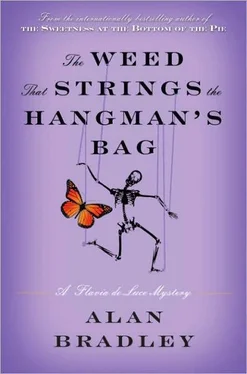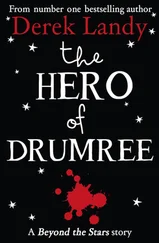Alan Bradley - The Weed That Strings the Hangman's Bag
Здесь есть возможность читать онлайн «Alan Bradley - The Weed That Strings the Hangman's Bag» весь текст электронной книги совершенно бесплатно (целиком полную версию без сокращений). В некоторых случаях можно слушать аудио, скачать через торрент в формате fb2 и присутствует краткое содержание. Год выпуска: 2010, Жанр: Исторический детектив, на английском языке. Описание произведения, (предисловие) а так же отзывы посетителей доступны на портале библиотеки ЛибКат.
- Название:The Weed That Strings the Hangman's Bag
- Автор:
- Жанр:
- Год:2010
- ISBN:нет данных
- Рейтинг книги:3 / 5. Голосов: 1
-
Избранное:Добавить в избранное
- Отзывы:
-
Ваша оценка:
- 60
- 1
- 2
- 3
- 4
- 5
The Weed That Strings the Hangman's Bag: краткое содержание, описание и аннотация
Предлагаем к чтению аннотацию, описание, краткое содержание или предисловие (зависит от того, что написал сам автор книги «The Weed That Strings the Hangman's Bag»). Если вы не нашли необходимую информацию о книге — напишите в комментариях, мы постараемся отыскать её.
The Weed That Strings the Hangman's Bag — читать онлайн бесплатно полную книгу (весь текст) целиком
Ниже представлен текст книги, разбитый по страницам. Система сохранения места последней прочитанной страницы, позволяет с удобством читать онлайн бесплатно книгу «The Weed That Strings the Hangman's Bag», без необходимости каждый раз заново искать на чём Вы остановились. Поставьте закладку, и сможете в любой момент перейти на страницу, на которой закончили чтение.
Интервал:
Закладка:
"I don't know what the world is coming to," Aunt Felicity went on. "I shudder to think of the people one meets nowadays — that man on the train, for instance. Did you see him on the platform, Flavia?"
I shook my head.
"Neither did I," she went on, "but I believe he kept back because he thought I'd whistle for the guard. Kept sticking his head into the compartment all the way down from London — asking if we were at Doddingsley yet. A rum-looking individual he was, too. Leather patches on his elbows and a bandanna round his neck like some brute of an apache dancer from Paris. It oughtn't to be allowed. I had, at last, to put him in his place.
"'When the train comes to a full stop and the signboard outside the window says "Doddingsley,"' I told him, 'we shall be at Doddingsley — and not a moment sooner.'"
Now it seemed that Daffy's brain had not only died, but that it had begun to curdle. Her right eye rolled off into one corner, while the other looked as if it were about to explode clean out of her head.
This was an effect she had been working on for years: the ability to bulge her eyes out in two different directions at the same time.
"A touch of the old exophthalmia," she had called it once, and I had begged her to teach me the trick. I had practiced in front of a looking glass until my head was splitting, but I could never manage more than a slight lateral googly.
"God moves in mysterious ways, His wonders to perform," she had said, when I reported my failure.
He did indeed. The very thought of Daffy's words had given me an idea.
"May I be excused?" I asked, already pushing back my chair. "I forgot to say my prayers this morning. I'd better see to them now."
Daffy's eyes uncrossed and her jaw dropped — I should like to think in admiration.
As I unlocked the door and walked into my laboratory, the Leitz microscope that had once belonged to Great-Uncle Tar shot me a welcoming gleam of brass. Here, close to the window, I would be able to adjust its reflecting mirror to focus a late beam of sunlight up through the specimen stage to the eyepiece.
I snipped a lozenge-shaped sample from one of the leaves I had brought from what I now thought of as the Secret Garden in Gibbet Wood, and placed it on a glass slide beneath the lens.
As I twiddled the focus, with the instrument set at one hundred times magnification, I found almost instantly what I was looking for: the barbed cystoliths that projected like thorns from the leaf's surface. I flipped the leaf over with a pair of tweezers I had pinched from Feely's mother-of-pearl vanity set. If I was correct, there would be an even greater number of these clawlike hairs on the underside — and there they were! — shifting in and out of focus beneath the snout of the lens. I sat for a few moments, staring at those stony hairs of calcium carbonate which, I remembered, had first been described by Hugh Algernon Weddell, the great botanist and globe-trotter.
More for my own amusement than anything, I placed the leaf in a test tube, into which I decanted a few ounces of dilute hydrochloric acid, then corked it and gave it a vigorous shaking. Holding it up to the light, I could see the tiny bubbles of carbon dioxide form and rise to the surface as the acid reacted with the calcium carbonate of the tiny spurs.
This test was not conclusive, though, since cystoliths were sometimes present in certain nettles, for instance. In order to confirm my findings, I would need to go a little further.
I was eternally grateful to Uncle Tar who, before his death in 1928, had bought a lifetime subscription to Chemical Abstracts & Transactions , which, perhaps because the editors had never been informed of his death, still arrived faithfully each month on the hall table at Buckshaw.
Piles of these enticing journals, each issue with a cover the exact blue of a mid-March sky, were now stacked in every corner of my laboratory, and it was among these — in one of the issues from 1941, in fact — that I had found a description of the then newly discovered Duquenois-Levine test. It was my own variation of this procedure that I was about to perform.
First I would need a small quantity of chloroform. Since I had used the last available bottle for a failed fireworks display on Buckshaw's south lawn to celebrate Joseph Priestley's birthday in March, I would first have to manufacture a fresh supply.
A quick raid below-stairs produced (from Mrs. Mullet's cleaning cupboard) a tin of chlorine bleaching powder, and from her pantry, a bottle of pure vanilla extract.
Safely back upstairs in the laboratory, I locked the door and rolled up my sleeves.
The tin of Bleachitol was, in reality, no more than calcium hypochlorite. Would calcium hypochlorite, I wondered, by any other name smell as sweet? Heated with acetone to a temperature of somewhere between 400 and 500 degrees Fahrenheit — or until the haloform reaction occurs — a quite decent chloroform may afterwards be extracted from the resulting acetate salts by simple distillation. This part of it was, as they say, a piece of cake.
"Yarooh!" I shouted, as I poured the results into a brown bottle and shoved home the cork.
Next, I stirred a half teaspoon of vanilla extract into a few drops of acetaldehyde (which, because the stuff is volatile and boils at room temperature, Uncle Tar had thoughtfully stored beneath a layer of argon in a sealed bottle), then tipped the mixture into a clean beaker into which I had already measured six and a half tablespoons of ethanol — plain old C 2H 5OH. This I had pinched from Father's sideboard, where it had lain unopened for ages after being brought him as a gift from a fellow philatelist who had been posted to Russia by the Foreign Office.
And now the stage was set.
Placing a fresh sample of one of the leaves into a clean test tube, I added a few drops of my alcoholic vanillin preparation (which I thought of calling the Duquenois-Levine-de-Luce reagent), and after waiting for a minute, just a nibbins of concentrated hydrochloric acid.
Again, as in my previous test, small bubbles arose in the tube as the carbon dioxide was formed, but this time, the liquid in the test tube turned quickly to a shade of blueish purple.
Excitedly, I added to the mixture a couple of drops of my homemade chloroform, which, since chloroform is not miscible in water, sank promptly to the bottom.
When the stuff had stratified into two distinct layers (the clear chloroform on the bottom and the blueish purple of the Duquenois reagent floating on top of it), I gave it a jolly good mixing up with a glass stirring rod and, holding my breath, waited for it to settle one last time.
It didn't take long: Now the chloroform layer had taken on the color of its upper blanket, the mauve of a hidden bruise.
Because I had already suspected the outcome, I didn't bother to cry "Eureka."
It wasn't parsnips Gordon Ingleby was growing in his secret glade: It was Indian hemp!
I had read about the stuff in an offprint of O'Shaughnessy's On the Preparations of the Indian Hemp, or Gunjah; Their Effects on the Animal System in Health, and Their Utility in the Treatment of Tetanus and Other Convulsive Diseases , a copy of which I had found tucked away in one of Uncle Tar's desk drawers.
Had Uncle Tar been using Indian hemp? Would that further explain his sudden and spectacular departure from Oxford as a young man?
Gunjah, or bhang, had long been known as an opium substitute, and Dr. O'Shaughnessy himself had reported great success in using it to treat a case of infantile convulsions.
And what more was Rupert's infantile paralysis, I thought, than muscular convulsions that would drag on cruelly, all day every day, until the last day of his life?
Testing the ends of the cigarettes that Gordon and Rupert had smoked was almost an anticlimax. The results were as I knew they would be. When I had washed up and put away the glassware (ughh! — how I loathe washing up!), I wrote in my notebook: Friday, 21st of July 1950, 9:50 PM.
Читать дальшеИнтервал:
Закладка:
Похожие книги на «The Weed That Strings the Hangman's Bag»
Представляем Вашему вниманию похожие книги на «The Weed That Strings the Hangman's Bag» списком для выбора. Мы отобрали схожую по названию и смыслу литературу в надежде предоставить читателям больше вариантов отыскать новые, интересные, ещё непрочитанные произведения.
Обсуждение, отзывы о книге «The Weed That Strings the Hangman's Bag» и просто собственные мнения читателей. Оставьте ваши комментарии, напишите, что Вы думаете о произведении, его смысле или главных героях. Укажите что конкретно понравилось, а что нет, и почему Вы так считаете.












